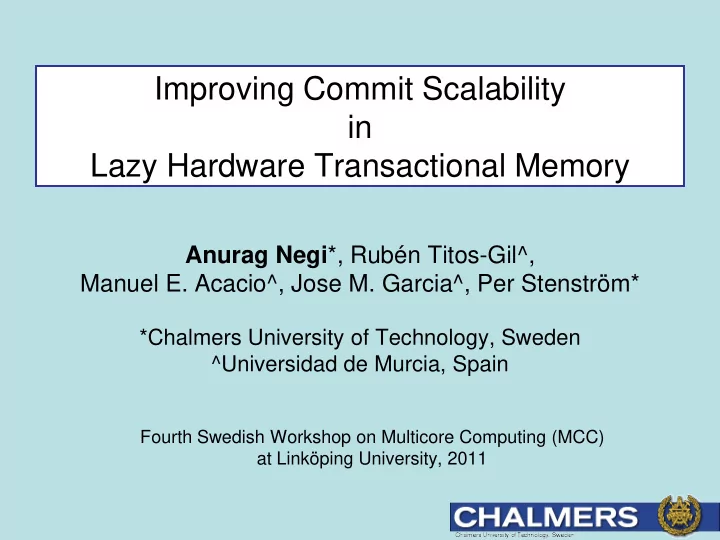

Improving Commit Scalability in Lazy Hardware Transactional Memory Anurag Negi *, Rubén Titos-Gil^, Manuel E. Acacio^, Jose M. Garcia^, Per Stenström* *Chalmers University of Technology, Sweden ^Universidad de Murcia, Spain Fourth Swedish Workshop on Multicore Computing (MCC) at Linköping University, 2011
Outline The importance of HTM The key challenges An approach to finding solutions Prior work and associated inefficiencies The π -TM approach
Where does HTM fit in the big picture?
HTM: Economy and Performance HTM Challenges • Manage design complexity Performance • Utilize existing mechanisms better FGLocks • Minimize changes required HTM • Improve performance Economy Productivity • Go lazy !! STM • Yet avoid bulk communication !!!
Managing complexity Use coherence protocol to detect conflicts early Managing design complexity by and utilize existing mechanisms better track these at cache line granularity No ad-hoc communcation hardware for TM Managing design complexity by and minimizing changes Piggy-back TM information on coherence messages
Improving performance Optimisitically run past conflicts Improving performance by going Minimize abort overhead lazy Utilize MLP better Lightweight commits using point- Improving performance by to-point messaging only avoiding bulk commuication between affected cores
Scalability of lazy commits Naïve: One at a time … the entire address space is one giant bank Better: Split address space into banks … lock all required banks prior to committing updates … ensure progress guarantees Ideal: Ensure conflicting transactions re-execute and prevent re-executions/new transactions from reading locations not yet updated
Prior Work • Detect early – Resolve late • Ad-hoc communication channel for EAZY-HTM[Micro2009] TM • Relies on directory communication for correctness Prevent other cores from accessing lines that are part of a committing transaction ’s write - The correctness concern set but haven’t yet been made globally visible
The correctness concern in more detail L1@Core1: {X old , Y old } TCommit@Core2: {X new , Y new } INV(X) L1@Core1: {Y old } D Core 1 commits an E inconsistent computation L Core1:TRead(X) X new A Core1:TRead(Y) Y old Y Atomicity requires Core1 INV(Y) to either see (X old ,Y old ) TCommit@Core1: {P, Q} or (X new ,Y new ) L1@Core1: {} but not (X new ,Y old ) The EAZY-HTM Approach Every first TRead or TWrite to a cache line communicates with the directory Ensures correctness but causes severe performance degradation
Reason for performance degradation Most cache lines accessed in a typical transaction are not contended Excessive communication with the directory causes congestion The π -TM Approach Speed up the common case Do extra work only for contended lines
The π -TM Approach Goals Speed up the common case Do extra work only for contended lines Design changes Add π -bit to track contended lines Pessimitically Invalidate such lines on commit or abort Other aspects No ad-hoc communication channel for TM TM info is piggy-backed on coherence messages
Incorporating adaptability Why? For short transactions with high contention , early conflict detection can increase transactional execution time Lazy Detection and Resolution Commit scalability problems but works well when application scalability is the dominant limiting factor (high contention) We employ a global commit token (GCT) scheme in such scenarios Each thread decides locally whether to use π -mode or GCT-mode Both π -mode or GCT-mode transactions can coexist safely Most applications run in π -mode
Estimating impact Baseline Faithfully implement Eazy-HTM information flow However, we use the NoC for communication (no ad-hoc communication) Coherence requests carry TM info as well π -TM is implemented on top of this baseline Adaptability mechanisms are enabled Other configurations evaluated EE: LogTM, an eager conflict resolution design LL-GCT: Global commit token (transactions commit on at a time) LL-STCC: A detailed scalable TCC implementation
Baseline Performance Effect of adaptability Best overall Improved commit performance bandwidth 4bars (L2R): π -TM EE(LogTM) 16 threads on 16 cores, SIMICS+GEMS, STAMP applications LL-GCT STCC
Conclusion π -TM achieves the following : A fully decentralized scalable commit protocol Only conflicting threads/transactions get affected Low design cost Performs the best among evaluated design points
Recommend
More recommend